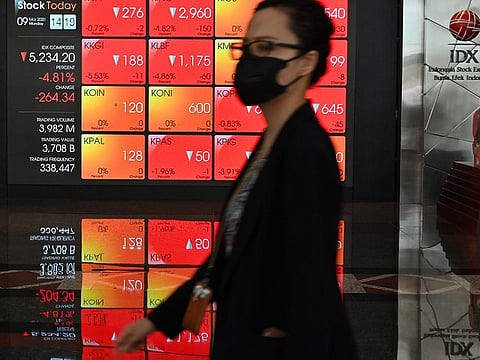Panic hits global markets amid threat of coronavirus and oil price slump
Global shares slide over rapidly-spreading coronavirus

Dubai: Stock markets in the UAE joined Asian peers in dropping nearly 10 per cent in early trading on Monday, as the world searches for a solution to containing the coronavirus outbreak.
But adding to investor worries is the sparking of a price war between Opec, led by Saudi Arabia, and Russia.
Everything hinged on a new production cut deal being struck between the major global producers… but that was not to be.
No deal
And the Monday mania on the stock and commodity markets showed what investors thought about the no-deal.
“For a good bulk of the market, this is a surprising outcome given the Covid19 (coronavirus) collapse in oil demand taking place,” said Stephen Innes, Chief Market Strategist at AxiCorp.
“Yet, this is not an unexpected outcome, as traders had feared such an OPEC+ breakdown since its very inception in late 2016.
“Russia despised the massive resurgence in US oil output, giving Washington carte blanche to set the global oil agenda and reshape the oil market pecking order to meet the miscellany of its interests as the world's preeminent economic and military power.
“Personally, as far as Moscow is concerned, I think the tipping point was the US imposed sanctions on Rosneft for marketing Venezuela oil.”
Oil Crashes 31% in Worst Loss Since 1991
Oil prices zoomed to levels of around $30 a barrel, brought on by a 25 per cent plus decline. Asian markets led by China and Hong Kong got caught up in the sell-off panic as well, and which was soon mirrored in the UAE, Saudi and Kuwait markets.
As the global oil benchmark plummeted to as low as $31.02 a barrel, Goldman Sachs Group Inc. warned prices could drop to near $20 a barrel
India’s Sensex went the same way, and so did the rupee, declining to an all-time low — Rs20.24 — against the dirham, before recovering some sanity.
But market watchers say to expect more of the carnage – unless the Reserve Bank of India decides to do some heavy hitting with its $476 billion in reserves to prop the rupee up.
Also Read: Rupee at new low to dirham of 20.24
Also Read: UAE stocks cannot escape the Asian flu
Also Read: China, Hong Kong stocks join in meltdown
With oil demand already plummeting due to the economic impact of the coronavirus, traders forecast that prices will go even lower.
“The oil market is now faced with two highly uncertain bearish shocks with the clear outcome of a sharp price sell-off,” said Jeffrey Currie, head of commodities research at Goldman Sachs in New York.
Brent for May settlement tumbled as much as $14.25 a barrel to $31.02 on the London-based ICE Futures Europe Exchange, the biggest intraday loss since the U.S.-led bombing of Iraq in January 1991.
It was trading 26% lower at $33.60 a barrel as of 7:49 a.m. in London.
Dramatic price drop
West Texas Intermediate crude slumped as much as 34% to $27.34 a barrel, subsequently paring losses to 28%. Trading was frozen for the first few minutes because of the scale of the drop.
While the price crash was dramatic, for oil specialists the movements in time-spreads, options and volatility are just as remarkable. Brent’s three-month price structure widened sharply as oil for prompt delivery collapsed against later shipments.
It moved deeper into contango, a sign of bearishness and oversupply, making it profitable for physical traders to buy crude and put it in storage, either in onshore tank farms or at sea on tankers.
Only haven in sight
Gold, meanwhile, became the safe bet all over again, inching past $1,700 an ounce mark for the first time since 2012.
Funds are piling into the metal. “Gold pushed rapidly higher throughout Asia and Europe on reported inventory demand for gold bars from Switzerland, and European vaults, which coincided with a headline from a Swiss health official saying that Switzerland is on the brink of an epidemic,” said Innes.
“A lower opening in US equities weighed further on risk sentiment and propelled gold towards the $ 1,700.”
In other words, this is the only asset that is shining bright for now.
Indian rupee is latest victim of coronavirus
The Indian rupee has touched a new mark against the dirham, trading at 20.24. The earlier low of 20.22 to dirham was in October 2018.
Through the morning session Monday, the rupee was hovering in the 20.14-20.16 range.
Currency traders and exchange houses are now looking to the Indian central bank to come up with a response. Will they let the rupee drop further? Or will they use the $476 billion in foreign reserves to prop it up?
“The Reserve Bank of India will help steady the rupee should it go into a freefall from this point on,” said Adeed Ahamed, CEO of LuLu Exchange. “Particularly if it breaches the 76 level to the dollar (it is now at 74.28).
“Considering the present scenario, we estimate the rupee to range between 72.90-74.35 against the dollar.”
Sign up for the Daily Briefing
Get the latest news and updates straight to your inbox







